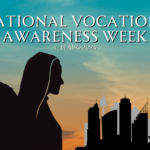Latest News
-
Alan
-
Fr Michael de Stoop: Biggest Bumper Crop in the Lord’s Harvest
By Fr Michael de Stoop - February 22, 2023 Reading Time: 10 minutes Seventeen men entered this year, the largest number in the history of the.
-
Super Seventeen enter Sydney Seminary
By Debbie Cramsie - February 22, 2023 Reading Time: 5 minutes Seminarians chat during a break at Good Shepherd Seminary in Homebush on 17 February. Photo: Alphonsus.
-
Sumner House: a vocations powerhouse of evangelisation
By Michael Kenny -September 11, 2021 | Reading Time: 4 minutes In a culture that pushes young men in particular not to commit to anything - or.
Events
August 2024
 National Vocations Awareness Week 2024
National Vocations Awareness Week 2024
September 2024
#WatchNow | Vocation Stories
Play Video
Play Video
